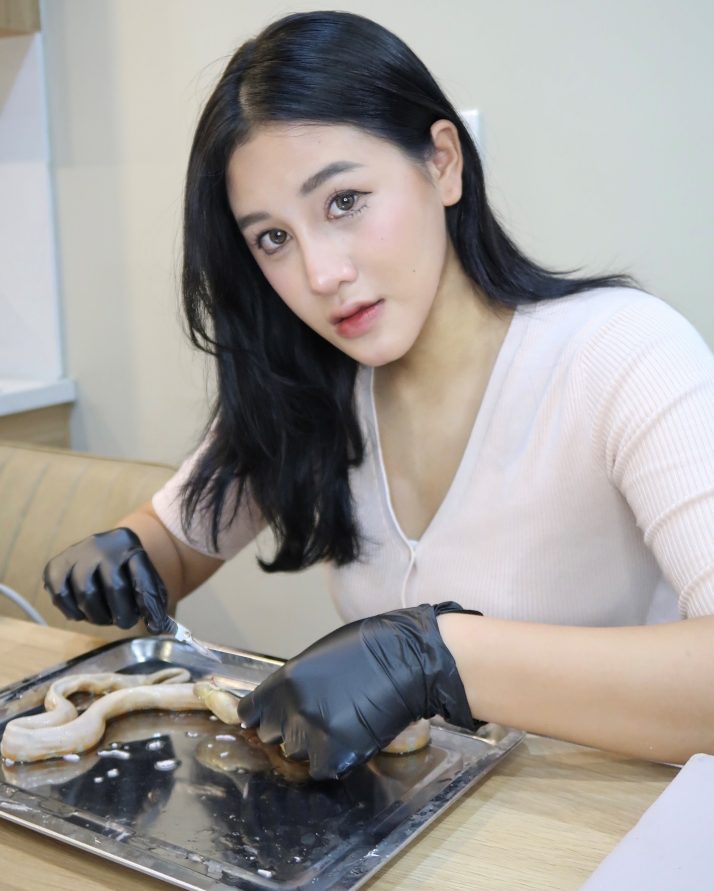Hidden in a small alley in the coastal city of Vung Tau, a unique gallery is drawing the attention of art and science enthusiasts alike. Here, a niche field known as diaphonization has been transformed into a vibrant and mesmerizing art form by Sally Tran, a young and passionate artist.
Sally Tran, whose real name is Tran Thi Mai Phuong, is a 21-year-old with a fascination for the unusual. While her peers engaged in conventional hobbies, Sally was captivated by creatures that others might avoid. Her childhood pets included snakes, turtles, monitor lizards, geckos, pythons, and even eagles. This early comfort with handling animals naturally led her to the art of diaphonization, a technique that involves meticulously staining animal skeletons to reveal their intricate internal structures.
Sally’s interest in diaphonization began when she was just a first grader, stumbling upon images of vividly colored animal skeletons online. The captivating beauty of these images ignited a curiosity that would lead her to explore diaphonization as a lifelong passion.
However, her journey into this art form was not easy. Diaphonization is a complex process that requires various chemicals and precise techniques, making it challenging for someone so young to pursue. It was not until she reached eighth grade, with the support of her father, that she could truly immerse herself in diaphonization. Seeing his daughter’s passion, Sally’s father set up a small laboratory for her, complete with protective gear and the necessary tools, allowing her to safely experiment and delve deeper into this intricate field.
After eight years of dedication and research, Sally officially opened her own diaphonization gallery in Vung Tau. Though it started quietly, the gallery has since attracted a loyal following and now showcases nearly 300 unique pieces of scientific art. These works range in price from VND200,000 for smaller pieces to several million Vietnamese dong for the more elaborate specimens.

“The field has grown significantly in the U.S., Japan, and Taiwan, where it’s seen as a unique hobby for those who appreciate both science and art,” Sally explains.
Each piece in Sally’s collection tells a story, not just of the animal it once was, but of the transformation that turned it from a simple skeleton into a work of art. Sally shares a personal experience that highlights her deep connection to this craft: “I buried one of my turtles 12 years ago, and when I dug it up, I found that its bones had completely disintegrated. I thought it was such a waste for something to just disappear like that.” This realization fueled her desire to preserve these creatures through diaphonization, turning them into unique and beautiful works of art.
In addition to displaying her work, Sally offers a service to create diaphonized specimens from deceased pets, with prices starting at VND500,000 for fetal or newborn specimens. Average-sized specimens range from VND2 million to VND10 million, with larger pieces commanding even higher prices.
The work is painstaking, requiring a delicate balance of chemical treatments and careful handling, but the results are undeniably striking. “For me, finishing these specimens is not just about preserving their beauty. It’s about giving them an eternal life after death,” Sally reflects.
Sally’s dedication to diaphonization comes with its challenges. “The chemicals used in diaphonization are highly toxic and pose significant health risks. I once had an infection from accidentally dropping a scalpel on my thigh while working,” she recalls.

Another challenge is the delicate process of staining the specimens. The vivid, almost otherworldly colors of diaphonized specimens come from staining, but it is the most difficult part of the work. If the staining fails, the specimen can disintegrate, meaning the loss of a creature that might have been someone’s beloved pet. While Sally has never experienced such a failure with her clients, the pressure to succeed is always present.
Sally emphasizes ethical considerations in diaphonization: “The true beauty of death is when it comes naturally, not when it’s caused to create art.” A prominent sign in her gallery reads, “100% of the specimens used for diaphonization were animals that died naturally.” Sally explains the importance of this message: “People often misunderstand and stigmatize diaphonization, thinking these specimens are the result of killing. So, I’ve had to explain and prove many times where they come from.”
 Sally is transparent about the origins of her specimens, which include lost pets, market fish, and even roadkill. These are not creatures sacrificed for art, but rather ones Sally believes deserve to be honored and remembered. Thanks to her efforts, people are gradually beginning to view diaphonization more positively.
Sally is transparent about the origins of her specimens, which include lost pets, market fish, and even roadkill. These are not creatures sacrificed for art, but rather ones Sally believes deserve to be honored and remembered. Thanks to her efforts, people are gradually beginning to view diaphonization more positively.
She also offers advice for newcomers: “It’s essential to have a deep respect for the specimens and to approach diaphonization seriously. It would be a shame to just experiment for the sake of it and then discard the work if it fails. I also recommend researching the science behind it thoroughly to achieve the best results and ensure your safety when handling animal remains and chemicals.”
Sally Tran’s work in this field is more than just a unique blend of science and art. It is a profound exploration of life, death, and the ways we can honor the creatures that share our world. Through her gallery, she invites others to see the beauty in the unexpected and to consider the many ways art can give life to what might otherwise be lost.









